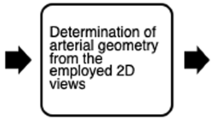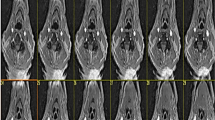Abstract
Recent advance in imaging modalities used frequently in clinical routine can provide description of the geometrical and hemodynamical properties of the arterial tree in great detail. The combination of such information with models of blood flow of the arterial tree can provide further information, such as details in pressure and flow waves or details in the local flow field. Such knowledge maybe be critical in understanding the development or state of arterial disease and can help clinicians perform better diagnosis or plan better treatments. In the present review, the state of the art of arterial tree models is presented, ranging from 0-D lumped models, 1-D wave propagation model to more complex 3-D fluid–structure interaction models. Our development of a generic and patient-specific model of the human arterial tree permitting to study pressure and flow waves propagation in patients is presented. The predicted pressure and flow waveforms are in good agreement with the in vivo measurements. We discuss the utility of these models in different clinical application and future development of interest.


Similar content being viewed by others
References
Stergiopulos N, Meister JJ, Westerhof N. Simple and accurate way for estimating total and segmental arterial compliance: the pulse pressure method. Ann Biomed Eng. 1994;22(4):392–7.
Fitchett DH. LV-arterial coupling: interactive model to predict effect of wave reflections on LV energetics. Am J Physiol. 1991;261(4 Pt 2):H1026–33.
Witzig K. Über erzwungene Wellenbewegungen zäher, inkommpressibler Flüssigkeiten in elastischen Röhren. Bern; 1914.
Womersley JR. Method for the calculation of velocity, rate of flow and viscous drag in arteries when the pressure gradient is known. J Physiol. 1955;127(3):553–63.
Westerhof N, Bosman F, De Vries CJ, Noordergraaf A. Analog studies of the human systemic arterial tree. J Biomech. 1969;2(2):121–43.
Avolio AP. Multi-branched model of the human arterial system. Med Biol Eng Comput. 1980;18(6):709–18.
Cassot F, Zagzoule M, Marc-Vergnes JP. Hemodynamic role of the circle of Willis in stenoses of internal carotid arteries. An analytical solution of a linear model. J Biomech. 2000;33(4):395–405.
Meister J–J. Mesure par échographie Doppler et modélisation théorique de l’effet de troubles cardiaques sur la pression et le débit artériels. Lausanne; 1983.
Schaaf BW, Abbrecht PH. Digital computer simulation of human systemic arterial pulse wave transmission: a nonlinear model. J Biomech. 1972;5(4):345–64.
Stergiopulos N, Young DF, Rogge TR. Computer simulation of arterial flow with applications to arterial and aortic stenoses. J Biomech. 1992;25(12):1477–88.
Zagzoule M, Marc-Vergnes JP. A global mathematical model of the cerebral circulation in man. J Biomech. 1986;19(12):1015–22.
Westerhof BE, van den Wijngaard JP, Murgo JP, Westerhof N. Location of a reflection site is elusive: consequences for the calculation of aortic pulse wave velocity. Hypertension. 2008;52(3):478–83. doi:10.1161/HYPERTENSIONAHA.108.116525.
Raines JK, Jaffrin MY, Shapiro AH. A computer simulation of arterial dynamics in the human leg. J Biomech. 1974;7(1):77–91.
Kufahl RH, Clark ME. A circle of Willis simulation using distensible vessels and pulsatile flow. J Biomech Eng. 1985;107(2):112–22.
Stettler JC, Niederer P, Anliker M. Theoretical analysis of arterial hemodynamics including the influence of bifurcations. Part I: mathematical models and prediction of normal pulse patterns. Ann Biomed Eng. 1981;9(2):145–64.
Stettler JC, Niederer P, Anliker M, Casty M. Theoretical analysis of arterial hemodynamics including the influence of bifurcations. Part II: critical evaluation of theoretical model and comparison with noninvasive measurements of flow patterns in normal and pathological cases. Ann Biomed Eng. 1981;9(2):165–75.
Alastruey J, Parker KH, Peiro J, Byrd SM, Sherwin SJ. Modelling the circle of Willis to assess the effects of anatomical variations and occlusions on cerebral flows. J Biomech. 2007;40(8):1794–805.
Taylor CA, Hughes TJR, Zarins CK. Finite element modeling of blood flow in arteries. Comput Methods Appl Mech Eng. 1998;158(1–2):155–96.
Cebral JR, Castro MA, Burgess JE, Pergolizzi RS, Sheridan MJ, Putman CM. Characterization of cerebral aneurysms for assessing risk of rupture by using patient-specific computational hemodynamics models. AJNR. 2005;26(10):2550–9.
Steinman DA. Image-based computational fluid dynamics modeling in realistic arterial geometries. Ann Biomed Eng. 2002;30(4):483–97.
Marzo A, Singh P, Larrabide I, Radaelli A, Coley S, Gwilliam M, Wilkinson ID, Lawford P, Reymond P, Patel U, Frangi A, Hose DR. Computational hemodynamics in cerebral aneurysms: the effects of modeled versus measured boundary conditions. Ann Biomed Eng. 2011;39(2):884–96. doi:10.1007/s10439-010-0187-z.
Crosetto P, Reymond P, Deparis S, Kontaxakis D, Stergiopulos N, Quarteroni A. Fluid structure interaction simulation of aortic blood flow. Comput Fluids. 2011;43:46–57. doi:10.1016/j.compfluid.2010.11.032.
Cheng C, Tempel D, van Haperen R, van der Baan A, Grosveld F, Daemen MJ, Krams R, de Crom R. Atherosclerotic lesion size and vulnerability are determined by patterns of fluid shear stress. Circulation. 2006;113(23):2744–53. doi:10.1161/CIRCULATIONAHA.105.590018.
Gerbeau JF, Chapelle D. Numerical simulation of the cardiovascular system. Med Sci (Paris). 2005;21(5):530–4.
Perktold K, Rappitsch G. Computer simulation of local blood flow and vessel mechanics in a compliant carotid artery bifurcation model. J Biomech. 1995;28(7):845–56.
Quarteroni A, Formaggia L, Veneziani A. Cardiovascular Mathematics Modeling and simulation of the circulatory system. Milan: Springer; 2009.
Taylor CA, Figueroa CA. Patient-specific modeling of cardiovascular mechanics. Annu Rev Biomed Eng. 2009;11:109–34.
Radaelli AG, Augsburger L, Cebral JR, Ohta M, Rufenacht DA, Balossino R, Benndorf G, Hose DR, Marzo A, Metcalfe R, Mortier P, Mut F, Reymond P, Socci L, Verhegghe B, Frangi AF. Reproducibility of haemodynamical simulations in a subject-specific stented aneurysm model—a report on the Virtual Intracranial Stenting Challenge 2007. J Biomech. 2008;41(10):2069–81. doi:10.1016/j.jbiomech.2008.04.035.
Yasargil MG. Microneurosurgery. Microsurgical anatomy of the basal cisterns and vessels of the brain, diagnostic studies, general operative techniques and pathological considerations of the intracranial aneurysms, vol I. New York: Thieme Medical; 1984.
Kelly R, Hayward C, Avolio A, O’Rourke M. Noninvasive determination of age-related changes in the human arterial pulse. Circulation. 1989;80(6):1652–9.
Holdsworth DW, Norley CJ, Frayne R, Steinman DA, Rutt BK. Characterization of common carotid artery blood-flow waveforms in normal human subjects. Physiol Meas. 1999;20(3):219–40.
Ford MD, Alperin N, Lee SH, Holdsworth DW, Steinman DA. Characterization of volumetric flow rate waveforms in the normal internal carotid and vertebral arteries. Physiol Meas. 2005;26(4):477–88.
Aaslid R, Lash SR, Bardy GH, Gild WH, Newell DW. Dynamic pressure–flow velocity relationships in the human cerebral circulation. Stroke J Cereb Circ. 2003;34(7):1645–9.
Reymond P, Merenda F, Perren F, Rufenacht D, Stergiopulos N. Validation of a one-dimensional model of the systemic arterial tree. Am J Physiol Heart Circ Physiol. 2009;297(1):H208–22. doi:10.1152/ajpheart.00037.2009.
Reymond P, Bohraus Y, Perren F, Lazeyras F, Stergiopulos N. Validation of a patient-specific one-dimensional model of the systemic arterial tree. Am J Physiol Heart Circ Physiol. 2011;301(3):H1173–82. doi:10.1152/ajpheart.00821.2010.
Vardoulis O, Coppens E, Martin B, Reymond P, Tozzi P, Stergiopulos N. Impact of aortic grafts on arterial pressure: a computational fluid dynamics study. Eur J Vasc Endovasc Surg. 2011;42(5):704–10. doi:10.1016/j.ejvs.2011.08.006.
Langewouters GJ. Visco-elasticity of the human aorta in vitro in relation to pressure and age. 1982.
Rogers PA, Kiyooka T, Chilian WM. Is there a need for another model on the pulsatile nature of coronary blood flow? Am J Physiol Heart Circ Physiol. 2006;291(3):H1034–5.
Martin BA, Reymond P, Novy J, Baledent O, Stergiopulos N. A coupled hydrodynamic model of the cardiovascular and cerebrospinal fluid system. Am J Physiol Heart Circ Physiol. 2012;302(7):H1492–509. doi:10.1152/ajpheart.00658.2011.
Leguy CA, Bosboom EM, Gelderblom H, Hoeks AP, van de Vosse FN. Estimation of distributed arterial mechanical properties using a wave propagation model in a reverse way. Med Eng Phys. 2010;32(9):957–67. doi:10.1016/j.medengphy.2010.06.010.
Stergiopulos N, Westerhof BE, Westerhof N. Physical basis of pressure transfer from periphery to aorta: a model-based study. Am J Physiol. 1998;274(4 Pt 2):H1386–92.
Westerhof BE, Guelen I, Stok WJ, Wesseling KH, Spaan JA, Westerhof N, Bos WJ, Stergiopulos N. Arterial pressure transfer characteristics: effects of travel time. Am J Physiol Heart Circ Physiol. 2007;292(2):H800–7. doi:10.1152/ajpheart.00443.2006.
Trachet B, Reymond P, Kips J, Swillens A, De Buyzere M, Suys B, Stergiopulos N, Segers P. Numerical validation of a new method to assess aortic pulse wave velocity from a single recording of a brachial artery waveform with an occluding cuff. Ann Biomed Eng. 2010;38(3):876–88. doi:10.1007/s10439-010-9945-1.
Papaioannou TG, Vardoulis O, Stergiopulos N. The “systolic volume balance” method for the noninvasive estimation of cardiac output based on pressure wave analysis. Am J Physiol Heart Circ Physiol. 2012;302(10):H2064–73. doi:10.1152/ajpheart.00052.2012.
Vardoulis O, Papaioannou TG, Stergiopulos N. On the estimation of total arterial compliance from aortic pulse wave velocity. Ann Biomed Eng. 2012;. doi:10.1007/s10439-012-0600-x.
Wan J, Steele B, Spicer SA, Strohband S, Feijoo GR, Hughes TJ, Taylor CA. A one-dimensional finite element method for simulation-based medical planning for cardiovascular disease. Comput Methods Biomech Biomed Eng. 2002;5(3):195–206.
van de Vosse FN, Stergiopulos N. Pulsewave propagation in the arterial tree. Annu Rev Fluid Mech. 2011;43:467–99.
Huberts W, Bode AS, Kroon W, Planken RN, Tordoir JH, van de Vosse FN, Bosboom EM. A pulse wave propagation model to support decision-making in vascular access planning in the clinic. Med Eng Phys. 2012;34(2):233–48. doi:10.1016/j.medengphy.2011.07.015.
Acknowledgments
This work was supported by the by the European Commission contract no. IST-027703@neurIST Project and by the Center for Biomedical Imaging (CIBM) of the Geneva-Lausanne Universities, the EPFL and the University Hospitals of Geneva and Lausanne. Special thanks go to Prof. Jean-Claude Chevrolet for his clinical expertise.
Author information
Authors and Affiliations
Corresponding author
Rights and permissions
About this article
Cite this article
Reymond, P., Vardoulis, O. & Stergiopulos, N. Generic and patient-specific models of the arterial tree. J Clin Monit Comput 26, 375–382 (2012). https://doi.org/10.1007/s10877-012-9382-9
Received:
Accepted:
Published:
Issue Date:
DOI: https://doi.org/10.1007/s10877-012-9382-9




